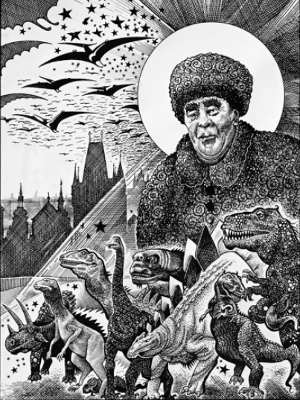At the last exhibition of Pavel Vošický in Gallery 1, I was talking about the inseparable link between his art and politics. Today I would correct myself a little. The artist does not place emphasis on politics but rather on history, specifically the history of totalitarian regimes. He started his work in the 1960s, but his most important work is from the 1980s, when the Marxist-Leninist utopia was heading for an embarrassing collapse. It is worth noting that no influential political scientist or kremlinologist predicted such a swift collapse. Vošický lived in the United States from the late sixties and he managed to depict the unsustainability of the absurd Soviet ideology with more clarity than some well-paid analysts.
Western elites are too focused on the idea of linear development, which mechanically connects causes to consequences. The common human experience does not confirm such strict causality. We know, that insignificant causes can have staggering consequences: in 1968 it took only a few out-spoken articles and caricatures in the Czech press to cause a mobilisation of an army of half a million from five countries of the Warsaw Pact. And it works the other way round, too. Totalitarian regimes tried very hard to create conditions which would lead to desired consequences, although in vain; social engineering coming from the scientific world view largely failed. The science at that time actually ceased to insist on strict causality. American mathematician, Edward Lorenz, came up with the term ‘the butterfly effect’ in 1979. It is a metaphorical example of the minor perturbations of the flapping of the wings of a butterfly being able to influence a hurricane on the other side of the world.
In the history that Pavel Vošický draws, there is no straightforward line that leads from causes to consequences. We see imaginary scenes, which the artist creates with his visionary anticipation. It does not explain anything, but instead shows something. Detailed works in each drawing can imply a myriad of meanings, leaving the spectator feeling as though he is wandering through a labyrinth. Every detail, even seemingly the most negligible, may be key to understanding historical development. Figuratively speaking, many butterflies are fluttering their wings in Vošický’s paintings. People later read about hurricanes initiated in such way in the press, and then in history textbooks.
There is one more thing worth noting. Vošický’s work was at its height of popularity in America during the eighties, shortly after Lorenz went to Washington to a meeting of The American Association for the Advancement of Science, where he spoke about the butterfly effect for the first time. Ten years later, on the other side of the world, a storm swept away the Communist regimes. The drawings in this exhibition can be interpreted as an illustrative application of Lorenz’s thesis on political affairs, but also as a demonstration of its validity. We cannot exclude it, that Pavel Vošický himself, far across the ocean, was fluttering the wings of his imagination so effectively, that he initiated the change of regime in his motherland. The change that no one expected, and that until today, seems a miracle.
published: 20. 8. 2015







